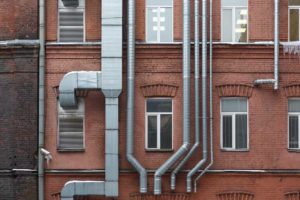This article about proactive mechanical ventilation maintenance has been provided by Tracey Wyber, Trackie Industries.
We see it all the time – strata properties that are allowed to fall into such a state of degradation that major repairs are required to fix the problem, leading to overblown budgets, huge disruptions and unhappy owners.
But there’s another way – having a preventative and proactive maintenance approach.
GET NOTIFIED WHEN WE PUBLISH NEW Q&AS, NEWS AND ARTICLES TO THE SITE
However, before we go any further, let’s explore exactly what mechanical maintenance is…
Mechanical maintenance involves looking after all the mechanical services in a building including:
- Controls
- Electrical systems
- Fans
- Duct work
- Carpark exhaust
- Toilet exhaust
- Fresh air
- Associated systems
What is involved in quarterly mechanical ventilation maintenance?
- Cleaning the system to ensure everything works efficiently
- Checking all electrical terminations are tight and there are no burnt cables
- Checking that all controls work as they are supposed to
- Inspecting, maintaining and carrying out greasing, fan belt changes
- Cleaning VSD fans cooling fans
- Test and calibrate atmospheric contamination systems
What are some of the consequences of not carrying out quarterly maintenance?
- Systems stop working altogether through mechanical or electrical failure
- Systems block up and air flow is compromised
- Mould build up appears
- In carpark exhausts, ducts become rusted out so dangerous gases cannot be removed from the carpark
- Large expense when equipment needs to be replaced
- Health of residents is compromised
- Extra energy expenses due inefficient and poorly maintained equipment
Food for thought…
We service our car on a regular basis to prevent a costly breakdown, why not do the same with our apartment blocks.
Case study
 What happens when regular mechanical maintenance is not carried out.
What happens when regular mechanical maintenance is not carried out.
This case study involves a lovely Eastern suburbs apartment block in Potts Point, Sydney. The residents of the building were becoming increasingly unhappy because they were noticing mould levels in their bathrooms on the rise and we all know mould and health do not go together.
Trackie were sent in to investigate the problem and started by checking air flow readings in each apartment. Not surprisingly, the air flow figures were low. Not enough air was being circulated through the ventilation systems of the building. AS1668.2 states, there must be minimum air flows in each bathroom to satisfy the standard.
The next step was to look at the rooftop fans to see what they were doing and once again, not surprising, they were not operating effectively, with one not operating at all. So, the fans were replaced, vents cleaned and the air flow reading were better, but still not up to scratch. Upon further investigation, it was found that many fire dampers had been placed incorrectly and were blocking air flow. Once rectified, the building began breathing beautifully again.
Moral to the story
This long and expensive (60K) process could’ve been avoided had the building had regular mechanical maintenance.
Have a question about strata committee meetings, emotional intelligence or something to add to the article? Leave a comment below.
Embed
Read next:
- NSW: Owners Corporation Run With No Meetings + No Maintenance
- NSW: Q&A Mixed Use Developments, Maintenance Bills and the BMS
- QLD: Q&A Who is Responsible for Maintenance of My Apartment Balcony?
This post appears in Strata News #300.
Tracey Wyber
E: tracey@trackieind.com.au
W: Trackie Industries
This article has been republished with permission from the author and first appeared on the Trackie Industries website.
Visit our Maintenance and Common Property OR Strata Topics by State pages.
After a free PDF of this article Log into your existing LookUpStrata Account to download the printable file. Not a member? Simple – join for free on our Registration page.

Leave a Reply